
by Mary Caperton Morton Thursday, October 2, 2014
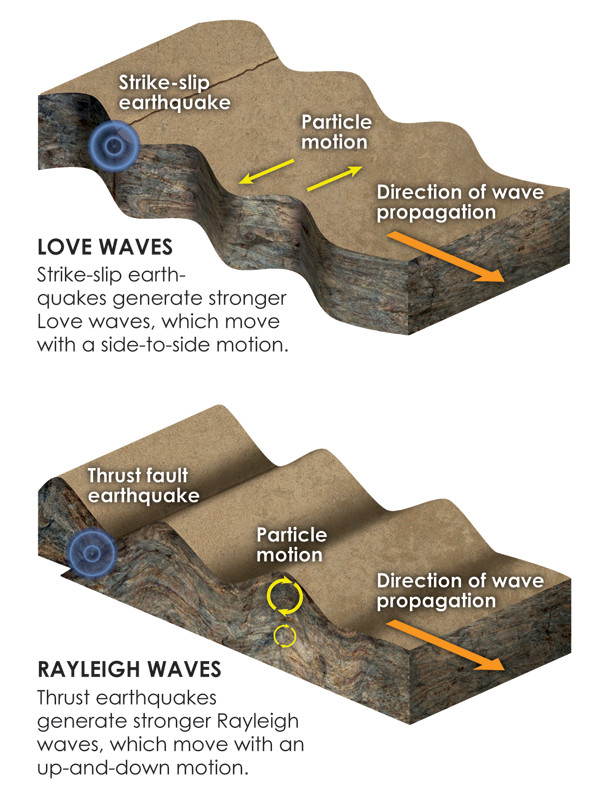
Credit: Kathleen Cantner, AGI.
When large back-to-back earthquakes hit Earth — and the headlines — many people wonder if the events are linked. Can one earthquake trigger another hundreds or even thousands of kilometers away? The answer, scientists say, is yes, although it appears the hazards of such triggering may not be that dangerous.
On June 28, 1992, a magnitude-7.2 earthquake near Landers in Southern California set off a series of tremors, microquakes and small temblors all over western North America, giving geoscientists their first hard evidence that large earthquakes may be able to trigger other seismic events over long distances. For 200 days after the Landers event, seismometers from southern Utah to Nevada to Idaho to Yellowstone — some as far as 1,250 kilometers away from the epicenter — recorded a surge of seismic activity, including hundreds of small earthquakes under magnitude 3.
“People had speculated that remote triggering of distant earthquakes might be possible, but prior to the Landers quake there wasn’t enough data to make the connection,” says David Hill, a seismologist with the U.S. Geological Survey (USGS) in Menlo Park, Calif. “There’s always a chance that what might look like triggering could just be coincidence, but Landers lit up the entire western U.S. within a matter of hours,” Hill says, “and it was clear that these distant faults were somehow talking to one another.”
Two decades later, improvements in seismic networks have shown that the Landers event wasn’t a fluke: Earthquakes greater than magnitude 7 seem to be able to set off other earthquakes all over the world, in all types of tectonic settings, through a phenomenon known as “dynamic triggering.”
“The more we look for evidence of dynamic triggering, the more we find, sometimes even on opposite sides of the world,” says Tom Parsons, a geophysicist at USGS in Menlo Park. “We’re used to putting out alerts after a big quake [that local residents should] expect aftershocks nearby, but should the whole planet be on alert?” Parsons asks. “Should the whole world be considered an aftershock zone?”
Scientists are also still trying to determine if a cascade of large triggered earthquakes is possible. So far, triggered earthquakes tend to be small to moderate in size, limiting the hazard potential. In the meantime, investigation into dynamic triggering of distant faults by passing seismic waves has been shedding some much-needed light on the fundamental physics of earthquakes, a field in which many theories remain as stubbornly uncertain as our capability for earthquake prediction.
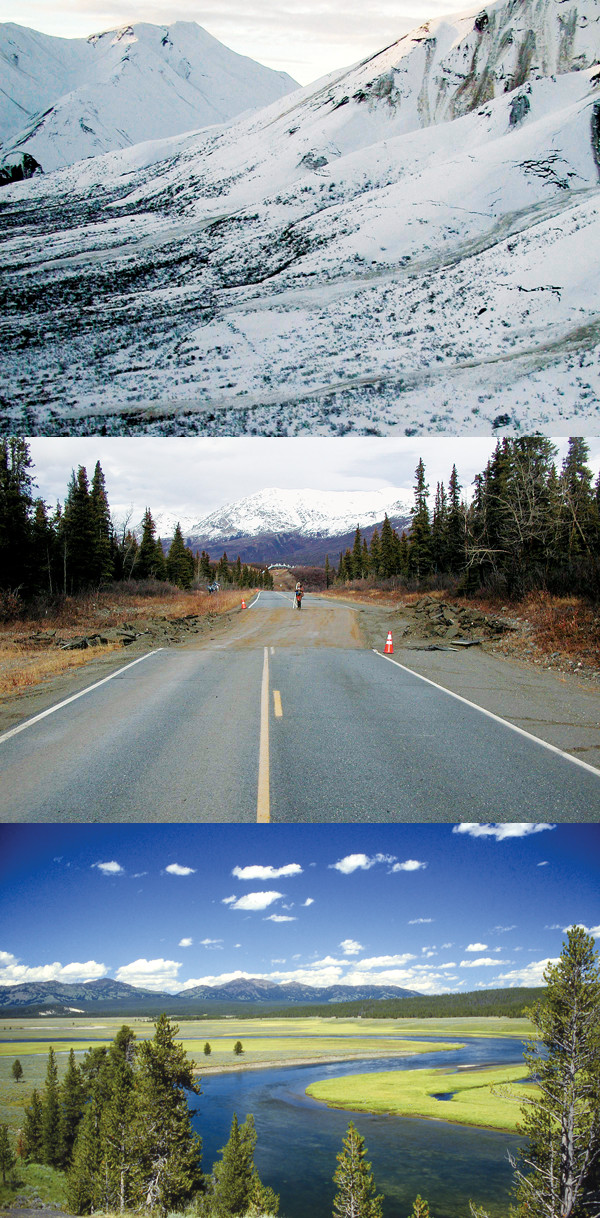
The Denali quake in Alaska in 2002 (fault trace in center of image at top, and close to 3 meters of horizontal displacement along Richardson Highway at center image, in Alaska) set off earthquakes in Yellowstone (bottom image). Credit: top two: U.S. Geological Survey; bottom: Ed Austin, Herb Jones, NPS.
Scientists have long known that stress changes in the crust and the motion of tectonic plates resulting from one earthquake can trigger additional seismic activity nearby in the form of aftershocks. Depending on the tectonic setting, this type of interaction, known as static triggering, can occur over a range of timescales — from hours to months after the mainshock — and distances, although it often affects the same fault system as the mainshock.
Dynamic triggering occurs when energy, in the form of seismic waves, passes through a distant fault system and triggers another seismic event in the form of tremors (quakes below magnitude 1), microquakes (below magnitude 2), or earthquakes. In some cases, these triggered events occur within seconds of the passage of seismic waves through an area, while others may be delayed by minutes, hours or days.
Seismic waves come in many forms, but surface waves — either Love waves, which travel with a side-to-side, snakelike pattern, or Rayleigh waves, which move with a rolling motion — seem to be the most effective at triggering activity along distant faults. “Love and Rayleigh waves have the highest-amplitude signal and are the strongest waves at long range,” Parsons says. “They also come in at very low frequencies, with periods of one second or longer, giving them time to apply some stress to the faults as they move through an area.”
The geometry of the rupture zone of the parent quake influences the types and strengths of the seismic waves produced. Strike-slip events tend to generate energy in the form of Love waves, whereas thrust events produce more Rayleigh waves. And in turn, Love waves tend to promote movement along other lateral-moving strike-slip faults, while Rayleigh waves usually set off thrust faults.
Dynamically triggered earthquakes can be studied in two ways: by looking at statistically significant increases in seismicity after a major event on a global scale, and by studying individual triggered events on a local scale.
Last February, in the journal Tectonophysics, Parsons and his colleagues published one of the largest studies to date on the so-called “global aftershock zone.” To study the global incidence of dynamic triggering, Parsons and colleagues looked at the effects of more than 300 magnitude-7 earthquakes since 1979 and found that only a very small percentage of mainshocks seemed to trigger seismic activity elsewhere.
“By looking at a whole bunch of mainshocks, we were able to pick out anomalous activity against the background of a constantly active planet,” Parsons says. By identifying outbreaks of increased activity across broad areas and then correlating those outbreaks with the arrival times of the surface waves, Parsons and colleagues showed that dynamic triggering is relatively rare — occurring after only about 2 to 3 percent of magnitude 7 or larger quakes — but that it occurs in a wide range of tectonic settings.
Other studies have focused on well-recorded single events, such as a magnitude-3.9 quake that struck near Nenana, Alaska, in April 2012 at the exact moment that the Love waves from the magnitude-8.6 Indian Ocean quake passed through the region. “We saw a slow, very large-amplitude wave rolling across Alaska and the moment it passed through central Alaska, this quake shook Fairbanks,” says Carl Tape, a geophysicist at the University of Alaska at Fairbanks who led a study on the Nenana event, which was published in Earth and Planetary Science Letters in January 2013. “The timing was so exact that there’s no question that the quake was triggered by the passing surface waves.”
Despite the globe-trekking nature of seismic waves, which can circle the planet many times after a major earthquake, dynamic triggering seems to be a relatively rare occurrence. “If dynamic triggering happened a lot, we probably would have noticed the link a long time ago,” Parsons says. “It would have become part of earthquake lore: If there’s a major quake somewhere, another is bound to follow elsewhere. But that just doesn’t seem to be the case.”
Whether passing seismic waves trigger movement along a fault seems to depend on a number of factors, including the magnitude of the quake that produced the waves, the distance the waves have traveled and the orientation of the fault with respect to the incoming waves. “Numerical modeling shows that the direction of stress imparted by passing waves is very chaotic, coming in one direction and then flipping and going in the other direction,” Parsons says. “It seems that waves have to strike the fault in just the right direction to get it to move, and even if the angle is perfect, the fault’s not going to move unless it’s ready to go already.”
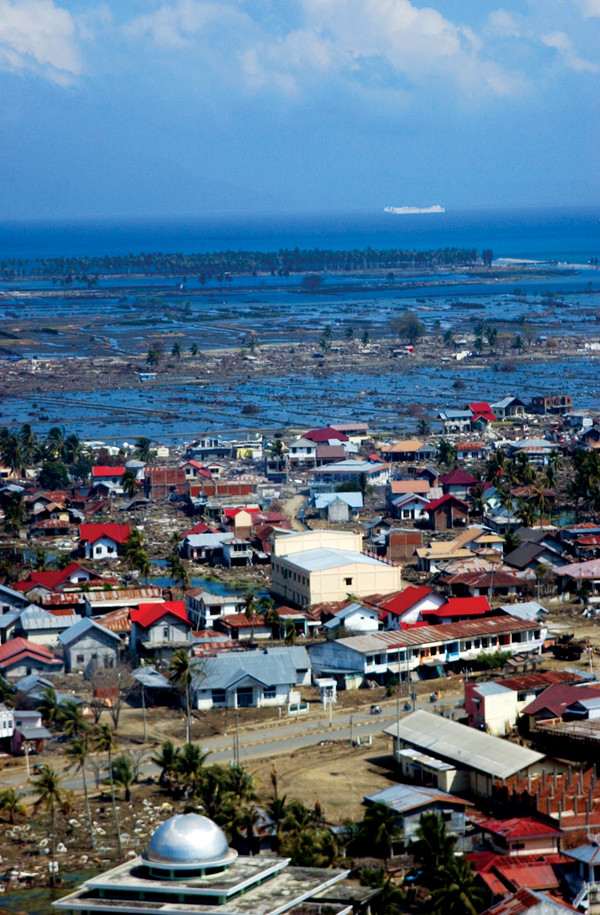
The coast of Banda Aceh, Sumatra, Indonesia, was devastated by the 2004 magnitude-9-plus earthquake and tsunami. It was struck again by an earthquake in 2012. Credit: Photographer's Mate 1st Class Jon Gesch, USN.
A triggered fault must be very close to failure because the forces imparted by seismic waves are actually quite small, Hill says, typically amounting to only a few kilopascals. “You can rub your fingers together and almost produce that amount of force.”
Some regions do seem prone to dynamic triggering, including extensional environments, like the western U.S., which is dominated by the Basin-and-Range Province stretching from the Wasatch Mountains in northern Utah, across Nevada to the Sierra Nevadas in eastern California. This region has seen increased seismic activity in the aftermath of several large earthquakes, including the Landers quake in 1992 and the magnitude-7.9 Denali (Alaska) quake in 2002, although not after the magnitude-9 Tohoku (Japan) quake in 2011 or the magnitude-8.6 Indian Ocean quake in 2012.
In other regions, susceptibility to triggering is less clear. For example, Japan has the best seismic network in the world, but few clear examples of triggered quakes have been detected there. Alaska also shows a historical dearth of triggered activity. And the San Andreas Fault in California (see sidebar) displays prodigious levels of triggering, but only in the form of small tremors deep in the crust. (A few potentially triggered events up to magnitude 3 have been detected.)
“I don’t think we understand the underlying mechanisms well enough yet to say why triggered quakes can occur in so many different tectonic environments, and yet are absent in some places,” Parsons says.
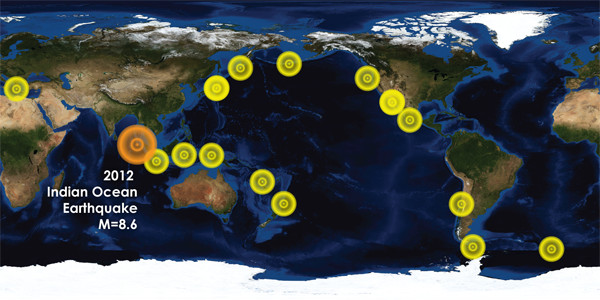
Map showing some of the larger aftershocks set off around the world by the Indian Ocean earthquake. Credit: Kathleen Cantner, AGI.
Additional clues could come from the aftermath of the 2012 magnitude-8.6 Indian Ocean earthquake, which set off aftershocks distributed around the planet. “If the amplitude of the seismic waves were most important, you’d expect to see more triggering closer to the mainshock, where the amplitude is highest, but that’s not the case,” says Ross Stein, a geophysicist at USGS in Menlo Park. Instead, the distribution of triggered aftershocks after the Indian Ocean event was strikingly uniform, suggesting that the period of the passing waves, which does not diminish with distance, may have the greater impact on faults close to failure.
“It seems like what matters is not how hard you kick the fault, but how long you sustain the kick,” Stein says. “Leaning on that fault for a significant amount of time is more important than hitting it hard, which tells us something about how faults nucleate that we didn’t know before.”
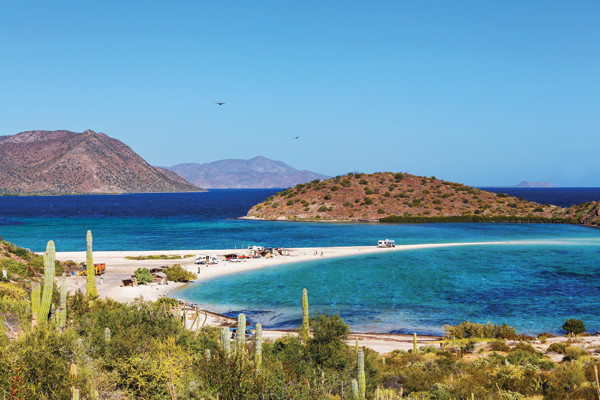
The Indian Ocean strike-slip quake is thought to have triggered earthquakes an ocean away in Baja California. Credit: ©Shutterstock.com/Galyna Andrushko.
The earthquake that struck the Indian Ocean near Aceh, Indonesia, on April 11, 2012, was the largest strike-slip earthquake recorded to date. The resulting Love waves were some of the highest-amplitude waves ever seen, and for a week after the mainshock, seismic activity along strike-slip faults around the world was elevated, with triggered earthquakes reported from Japan to Mexico.
Within hours of the Indian Ocean earthquake, a series of quakes between magnitude 3.7 and 6.1 struck the previously quiet Baja Peninsula in Mexico, culminating in a magnitude-7 earthquake that occurred 24 hours after the Indian Ocean event.
“It’s very difficult to be confident that an earthquake in the Indian Ocean is responsible for an earthquake in Baja or Oregon or Alaska, especially when it occurs hours or days after the mainshock, but the statistics build a very compelling case,” Stein says.
“Before the Indian Ocean event, I would have bet a lot of money that there’s no such thing as dynamic triggering, at least at the scale that we care about for hazards,” Stein says. “If triggered quakes aren’t larger than magnitude 4, they don’t amount to beans when it comes to hazard. But if larger quakes can be triggered, it changes the whole game,” he says.
For example, he adds, think about earthquake insurance. “One of the founding principles of earthquake insurance is that earthquakes are localized events. If you could have simultaneous knockout punches in Los Angeles, San Francisco and Tokyo, there could be serious financial implications.”
The Indian Ocean earthquake was unusual in its size, however, and its aftereffects may represent a very rare occurrence. In his opinion, Stein says, a global aftershock zone featuring large earthquakes is “unlikely to happen again anytime soon.”
Efforts to mine records of past major strike-slip events, like the magnitude-7.8 San Francisco earthquake that struck in 1906, for more evidence are hampered by a lack of detailed seismic data. But there is some evidence of far-reaching aftershocks: In the hours after the San Francisco earthquake, earthquakes up to magnitude 6.1 were reported near the Salton Sea in Southern California, in western Nevada and in western Arizona, as far as 1,000 kilometers away from the epicenter. Of course, whether these other events were triggered by the mainshock or were mere coincidence is impossible to prove, Hill says.
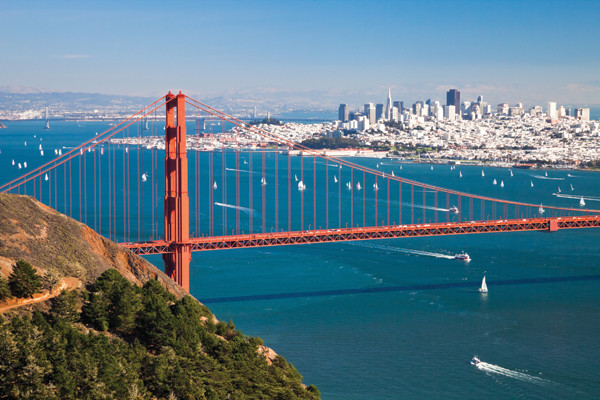
According to geophysicist Stephanie Prejean, although remote triggering of large earthquakes in cities such as San Francisco is possible, "people who live in seismically active zones probably should be more worried about the earthquakes that are going to occur anyway rather than the remote possibility of this triggering process." Credit: ©Shutterstock.com/ kropic1.
In the 22 years since Landers, the majority of seismic evidence suggests that most triggered quakes are small to moderate. Whether a triggered event could be large, however, is another question, as is whether a major quake could remotely trigger a cascade of smaller earthquakes culminating in a larger triggered rupture.
The series of quakes that struck the Baja Peninsula after the Indian Ocean earthquake could be an example of just such a triggered cascade, as it fits the hypothesized description, says Roland Bürgmann, a geophysicist at the University of California at Berkeley. However, he says, “I wouldn’t call it the smoking gun. What we need is to find a series of quakes that start exactly with the passage of the surface waves.”
Part of the challenge of finding evidence for such cascading behavior is that small triggered events usually happen instantaneously, as the seismic waves pass through the fault. But larger events, as in Baja, often seem to come with a delay of hours to days, making it difficult to conclusively link the passing waves with the subsequent event. “Establishing causation between events is always a tricky business, especially as the time delay between them gets longer,” Parsons says.
“So far, it’s been very difficult to definitively correlate a large earthquake with passing surface waves generated by another quake,” Parsons says. “I expect that it can happen, but it doesn’t seem to be a significant contributor to global earthquake hazards.”
That seems to be the general consensus. “People who live in seismically active zones probably should be more worried about the earthquakes that are going to occur anyway rather than the remote possibility of this triggering process,” says Stephanie Prejean, a geophysicist at USGS in Anchorage.
Still, dynamic triggering is worth studying as a unique window into the mechanics of how earthquakes rupture, and it could provide a glimpse into the model of cascading earthquake propagation.
Earthquakes are thought to begin in one area of a fault — the nucleus — and spread, or propagate, outward, with the length of the rupture directly correlating to the magnitude of the event. But the physics remain a mystery.
Geoscientists have many theories for how earthquakes rupture, but being in the right place at the right time to make observations in the field is next to impossible, and replicating the forces and faults involved in the lab has also proved challenging. One theory holds that gradual buildup of tectonic stress leads to microscopic cracking along a locked fault, which can coalesce into a larger rupture. Other theories suggest that the migration of fluids along faults can weaken the fault zone and bring it closer to rupture.
“We like to argue about the different mechanisms and which might be dominant, but the reality is that there are probably multiple mechanisms at work in any given fault zone and what we’re seeing is the sum of everything working together,” says David Shelly, a geophysicist at USGS in Menlo Park.
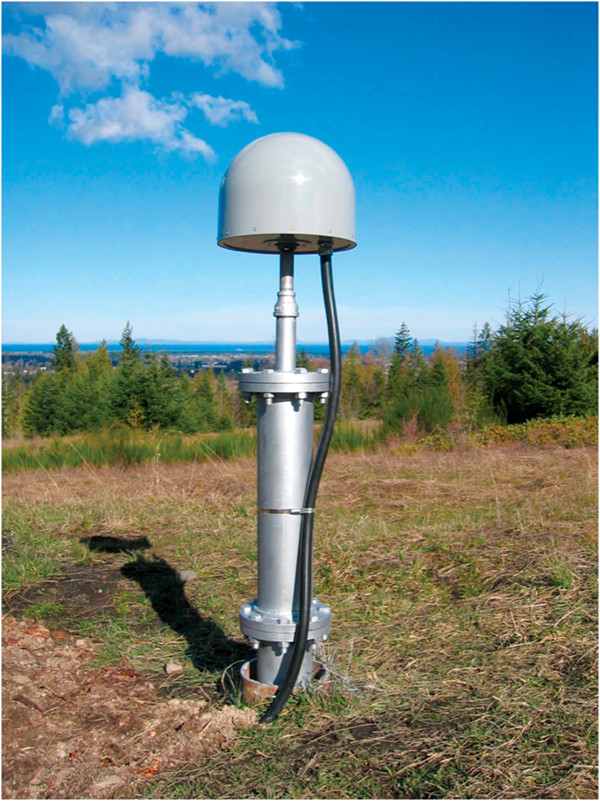
uments such as borehole strain meters and GPS antennae (mounted on the strain meter casing) help scientists learn more about remotely triggered earthquakes. Credit: UNAVCO.
Improved instrumentation in the future may help scientists better understand dynamic triggering. “In many places, data quality continues to be a struggle,” Prejean says. “We need more cases of dynamic triggering where we also have complementary data streams from many types of instruments other than seismometers to help us put the whole picture together.”
Strain meters and borehole meters that measure strain deep in the crust will help, as well as more ambient noise tomography studies, which track velocity changes in the crust. “Those kind of aseismic data will help track down the physical processes that are driving dynamic triggering,” Prejean says.
More instruments means more data, which requires more people in order to stay ahead of the constant stream of new information. “We’re living in an interesting time with a lot of very large earthquakes being recorded by very good seismic networks,” says Aaron Velasco, a seismologist at the University of Texas at El Paso. “It’s almost too much data to wrap your mind around. Dynamic triggering is beyond any one individual” to sort out, he says. “It’s going to take a team effort and a lot of collaboration to figure it out.”
Ultimately, a better understanding of dynamic triggering could lead to better earthquake prediction, the holy grail of seismology and geophysics. “Dynamic triggering might be more important than we think,” Stein says. “It raises a lot of big questions that, if we can answer, might be the key to better earthquake prediction.”
© 2008-2021. All rights reserved. Any copying, redistribution or retransmission of any of the contents of this service without the expressed written permission of the American Geosciences Institute is expressly prohibited. Click here for all copyright requests.